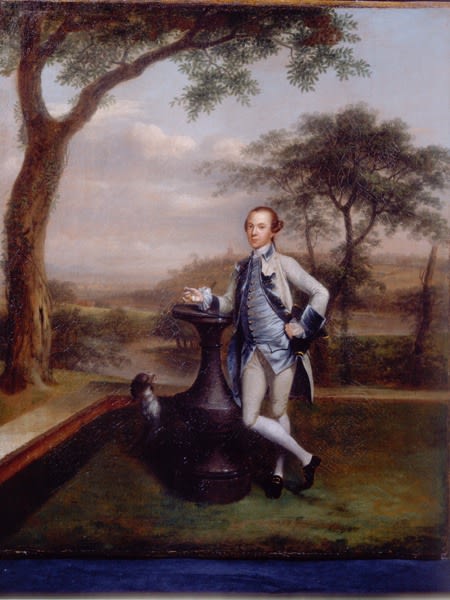
Arthur Devis
To view all current artworks for sale visit philipmould.com
In portraits such as these Arthur Devis allows the viewer a remarkable glimpse of the gentlemanly world of the mid-eighteenth century. Much of his appeal to modern buyers, and to students of Georgian interior design, landscaping and costume, lies in the way these vignettes seem to reveal an instant of their sitters’ lives, like a snapshot presented without apparent artifice. These portraits, typical of Devis’s work, particularly of his work in the 1750s, exemplify his trademark small full-length portraits placed in an extensive landscape. One gentleman stands before a landscape in the distance of which is a cathedral city, perhaps, it has been suggested, representing Bristol. The sitter in each portrait occupies his extensive surroundings with an indefinable air of entitlement, as if the land stretching as far as the eye can see is all his own. In earlier portraits Devis had placed his sitters in cavernous Palladian interiors which often, through knowledge of the sitters, we recognise that they could not have inhabited. Instead the setting is intended as a socially appropriate space for the sitter. It is unfair to suggest that Devis was merely pedalling social fantasy to his sitters – his clientele was neither as urban nor as bourgeois as is often assumed – but it is undeniable that the repetition in these interiors of the same props, the same tripod table, the same hanging bird-cage and even the same paintings suggests that he indulged many of his sitters in the appearance of fashionable and gentlemanly living.
Whether the landscapes seen in Devis’s portraits are equally fantastic is hotly debated, but in those paintings where the landscape or elements of it have been satisfactorily identified the objects intended are quite specific. The terraces on which they stand are more straightforwardly formulaic. They form a convenient enclosing device separating the social world of the sitter from nature beyond. They are based on no more than a general form popular at the time and the same terrace appears in The Misses St Aubyn 1754 (Private Collection), as it does in A Portrait of William Ingle 1752 (ex Ingle Family), which also employs the same sundial. This element was certainly not intended to be read other than as a form of staging, and in the two portraits of the Misses Warden 1751, each depicts the sitter before the prospect of a rusticated fishing pavilion – quite probably, therefore, a true feature of their house – but employs a different foreground device, to place one sister on a brick terrace as in our portraits and the other on the stone steps of a peron.
In dressing his sitters Devis, like many painters, had a standard repertoire of costume. The white suit with blue facings that is such an elegant part of the tonal harmonies in the Portrait of a Gentleman leaning on a sundial is as much a cliché of Devis’s work in the 1750s as the white waistcoat is of Thomas Hudson’s. An identical example is worn in the Portrait of Thomas Lane 1755 (unknown collection), and again in Portrait of an Unknown Gentleman perhaps the Earl of Dundonald 1755 (ex collection The Earl of Dundonald) where the sitter is also standing on a brisk-walled terrace as in our portraits and is leaning on a plain green-painted chair with a railed back and round seat, a further, frequent prop of Devis’s garden portraits.
Provenance
Mrs K. Chapman;Her sale Christie's, 25th February 1949, lot 136, bought by More for 80gns;
Private Collection, Oxfordshire